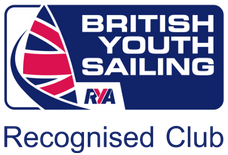Training Boat Rigging Guides
We have three types of training boats, and each type is rigged slightly differently. This page has a basic guide on each type of boat - but we will no doubt have local differences that will need a bit of imagination. In general, Don't undo splices or “bobbles” - they are there for a purpose and in the correct place. Don't undo things using tools such as spanners or screwdrivers, there will be an easy way to do things without needing any engineering work. (The exception is if your hands are very cold and cannot grip any more)
Please do your very best to make sure boats are put away safely and correctly for the benefit of whoever follows you in the next session. There is a place for most things - please put them back there so we can find them again!
Laser 2000
Our two Laser 2000s are rigged nearly identically. The PDF that follows is the standard one from Laser explaining how to rig the boats from scratch. Two important things to save embarrassment and significant cost;
- The Laser 2000 mast is held up by Jib tension alone when sailing. When you unrig, don't forget to replace the fore stay before you release the tension
- Use the ring to hold the Rudder on securely to the pintles. These assemblies are very expensive and don't float.
One of the boats has a trapeze rigged. If you don't know what to do, leave it alone! Here are the instructions on rigging from scratch.
Laser 2000 Rigging Guide (pdf)
Trapeze Warning
Don't use the trapeze unless the lowers are in place and correctly tensioned. The mast could break.
Lowers
The lowers should just be in tension and equal on both sides and not pulling the mast back. They should be tensioned once the rig tension is applied fully to the fore stay and jib halyard. Their purpose is to support the forward forces applied to the mast when load is applied to the mast by your gorilla on a string.
Laser Standard, Radial and 4.7
Choose your rig size as appropriate to your own size and ability. Take the rig and a boom to the boat and unroll the sail. Take the complete foil bag out to the boat as well. Insert the three battens into the sail.
Insert the mast into the hole, and then attach securely to the boat via the short rope strop. If you don't and then capsize, the mast can fall out - or worse, fall partly out and break the hull.
The three sail controls need attaching. The kicker is a standalone system that attaches the mast via a pin and ring. Don't tension up until on the water to keep the sail de-powered.
The clew outhaul needs strapping to the boom, and the rope needs feeding down the mast via the small block and then though the controls on the deck behind the mast. Loop up the spare rope to keep it tidy and prevent it tangling around your feet. We have set up a short strop that goes around the boom and secures the sail correctly. This should be in place on the sail, and it stays there. Feed the bobble through the loop to hold it in place.
The downhaul/Cunningham is threaded to get extra purchase through blocks and also is led through the controls on the deck.
The mainsheet is then threaded from the end of the boom becket on the block, to the block on the traveller, up to the boom end block, back along the boom through a loop (so you don't get strangled) through the pulley block on the boom to the ratchet block in the cockpit (make sure it runs the right way) and ends with a stop knot.
Don't forget to tie the rudder on once it is on its clips, and use the elastic to attach the dagger board.
When you have finished sailing, take the boat apart and store the bits safely. Take the battens out, put them in the foil bag, and roll the sail up nicely. Put the cover on the boat.
Here is a "standard" rigging guide for reference. We also have the better XD control system in place. See full installation guides if you are confused. If our boats look slightly different please do not change them if you can see how they work. We have probably done a minor adaptation to make it easier to maintain.
XD down and out haul Laser Rigging Guide (pdf)
XD kicker Laser Rigging Guide (pdf)
RS Fevas
RS provide at least two rigging guides. Here is the simpler one. You can search the Internet to find a more complicated one if you are faced with rigging the boat from a set of components
Toppers, 5.3 and 4.2
Chose your rig, and take it and the boom to the boat. Put the mast in the mast gate and lock it in, using the pin to make sure it cannot come out by accident.
Unroll the sail (no battens) and attach the clew to the boom using the hook that slides along the boom. Check the outhaul is attached and is worked from the cleat under the boom at the front.
Kicking strap is connected from boom to mast. There should be one on every mast ready for use. Do not take it off when you are finished.
The mainsheet is then threaded from the end of the boom to the block on the traveller, up to the boom end block, back along the boom through a loop of material (so you don't get strangled) through the pulley block on the boom to the block in the cockpit and ends with a stop knot.
Don't forget to tie the rudder on once it is on its clips, and use the elastic to attach the dagger board.
When you have finished sailing, take the boat apart and store the bits safely. Roll the sail up nicely around the mast. Put the cover on the boat if there is a spare one ready for use. Put the other boats upside down on the Topper Rack.
Here is a "standard" rigging guide for reference.
Locations
We have kit scattered around the site, as we do not have a large enough location where it can all go. However, here is an approximate list of the locations for the majority of equipment.
Laser 2000
- Rudders and Tillers, in the Garage
- Trapeze harness - we need to acquire one, but we will keep in the Garage
- All of the rest including sails is in the boat
Lasers
- Masts - three types of mast in the garage
- Centreboards and Rudders - in the foil bags in the Garage (on floor)
- Ropes, battens and kicker etc - in the foil bags
Toppers - both sail sizes
- Masts - two pre-rigged types of mast in the garage
- Centreboards and Rudders - in the foil cupboard in the dinghy park
- Mainsheets - in the foil cupboard in the dinghy park
RS Fevas
- Masts - upright in the boats
- Booms, ropes and foils, also in the boats
- Sails - there are two sets of sails. Please use the softer “training” sails unless you are going to be racing.
Personal safety kit
- Buoyancy Aids - in the blue container in the far car park
- Helmets - in the foil cupboard in the dinghy park




